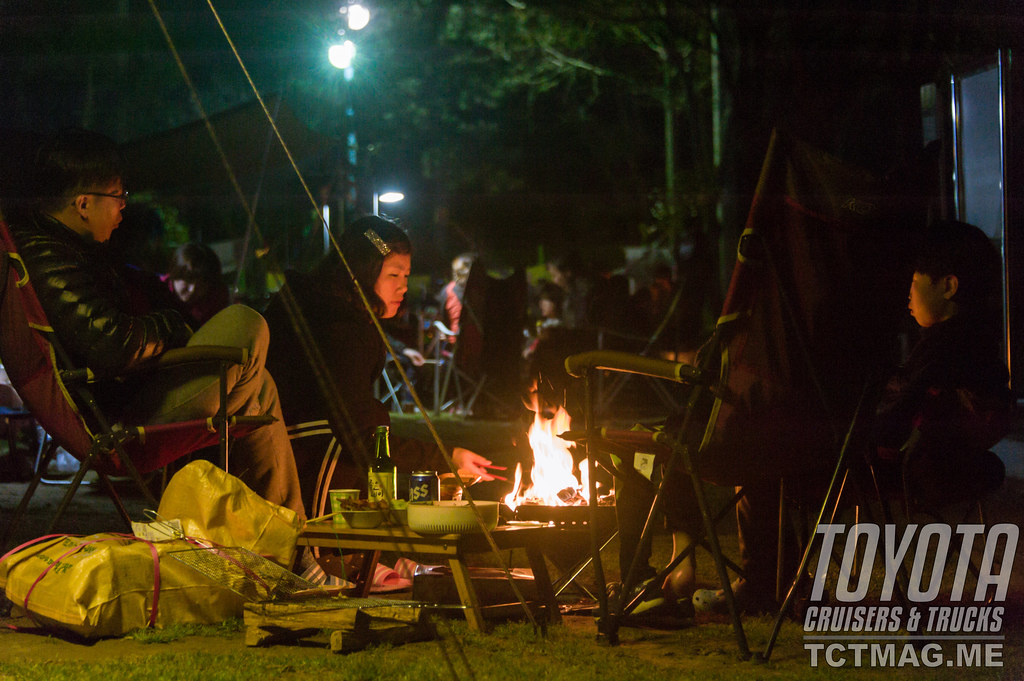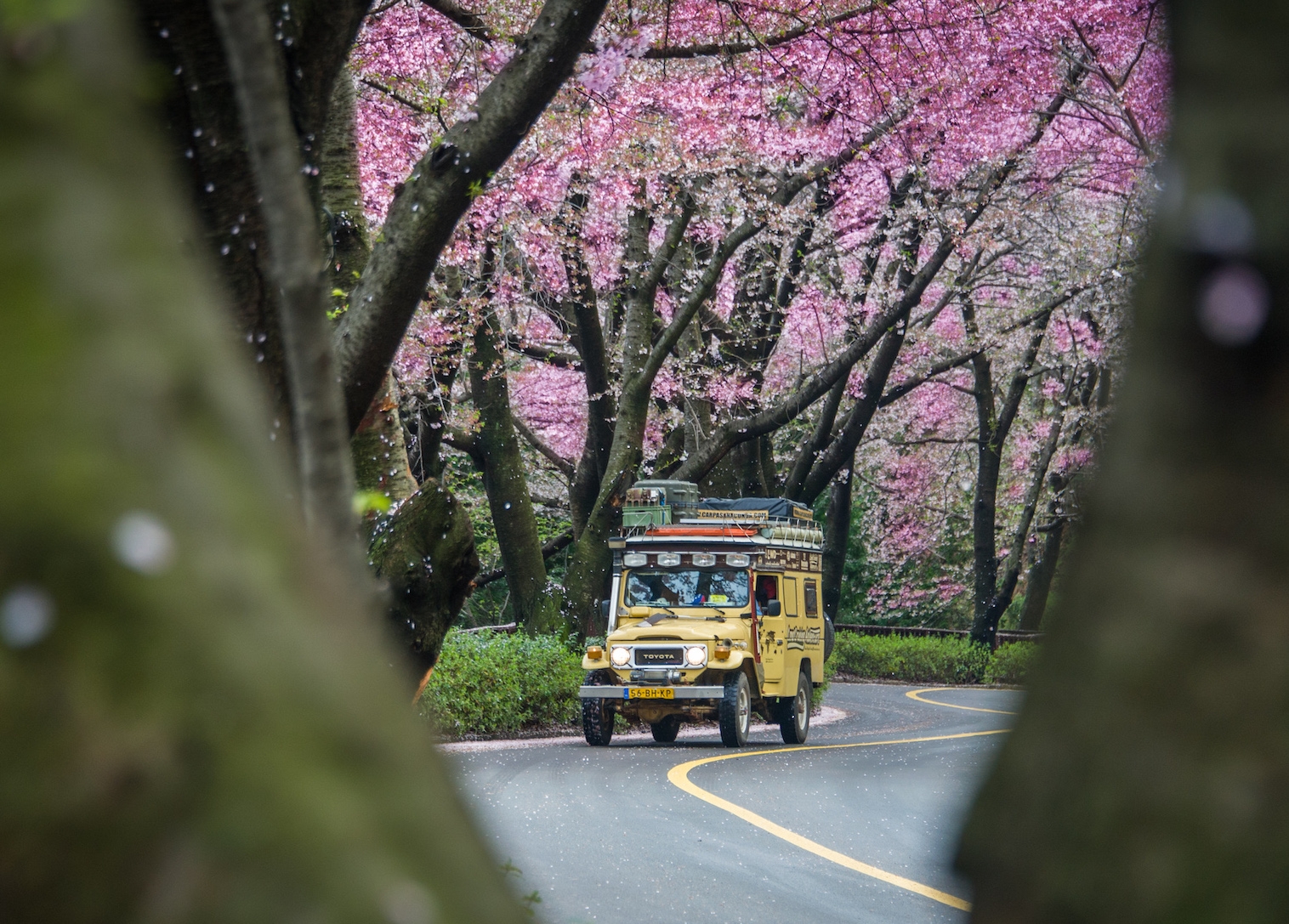At the entrance gate we are welcomed by four statues of massive, colorful guardian gods with bulging eyes. They fend off evil and protect the world. Each carries a symbol, such as a lute, a dragon or sword, by which you recognize who is who. Buddhist temples are colorful with lots of depictions of lotus flowers and dragons. At the same time, they radiate serenity with quiet, shady corners where you can just sit and be still for a moment.

A daily ritual: changing of the guards.
The Charm of Overlanding in South Korea
Being a highly developed country, South Korea is largely covered in asphalt. If overlanding implies off-roading to you, South Korea may not feature on your overland-travel bucket list. However, this small peninsula in the Far East has so many other things to offer: a rich history and culture which you find in temples and daily life, informative and well-maintained museums, modern architecture, ancient graveyards, gorgeous mountains (hiking is big here), and a coastline with some sandy beaches.

Happily reunited with our Land Cruiser.
The charms of the country are not necessarily far away from the asphalt, but you do need to get off the highway. That in can be quite an adventure. Overlanding in South Korea has its own challenges. For one, you can’t use Google Maps to plan a route because the government has disabled that function. We assume this has to do with its relationship with North Korea. Guru Maps and MapsMe, two of the apps we regularly use, lack many roads and are unreliable. The main cities and immediate surroundings are a mishmash of expensive toll roads that we prefer to avoid.
Find our Way Around a New Country
Getting out of Busan, the main city and port in the southeast of the country, is a challenge. From the first bridge, the GPS indicates a route north to a second bridge. We see the bridge but can’t figure out how to get there and drive a loop back to our starting point. We try another turnoff and get lost once more. When we have found a way back to our route, we are stopped by a barrier. Maximum height is 8 feet 20. Our Land Cruiser is 8 feet 80. We turn around, zigzag some more and not being able to get to that second bridge, we return to the highway once more, me getting my wallet from the glove department, ready to start spending money on toll fees.
The joy of traveling in a new country is that everything is exciting. It does take ages and an effort to figure out, but then, we are in no hurry. We have just arrived in the country, having shipped the Land Cruiser from South America to South Korea, and have to stock up. Not speaking the language it isn’t evident to ask for directions or to find a bank with an ATM to withdraw money. Having completed that mission, we’re on for the next: finding a supermarkt. Once inside we wonder how hard can it be to get rice. It isn’t hard as such, but smal quantities aren’t evident: 3, 5, and 10-kilo and even 20-kilo bags are common. Not yet being able to decipher the alphabet, it takes ages to figure out what is in some of these elaborate food packages. We learn there are dozens of types of tofu, miso, and seaweed, and all kinds of mushrooms we have never seen before. Strawberries and many other fruits are sold in big quantities and apples are huge. A food adventure has started and will lead to a big change in our daily menu after years of rice and beans in South America.
Hospitality

Selfie time in front of flowering trees.
We are lucky to have arrived in the cherry blossom season, which is in the beginning of April. An asphalt road winds along the Animingogae Ridge above the town of Jinhae, supposedly one of the hot spots in this season, and rightfully so. Left and right pink trees line the road and with a breeze, the light pink petals flutter down like snowflakes. It is utterly enchanting. Locals love this season, which to them announces the start of spring. People are everywhere. Never in our lives have we seen so many people, all happily smiling, giving thumbs and the V-sign to take the umpteenth selfie in front of flowering trees.
In a parking lot we are invited by a woman to come and stay at her place. Thus, we meet Rachel, who has traveled a lot in between jobs of teaching Engineering and English. She lives in a house with a bed/living room with floor heating. She insists we sleep in her double bed while she moves to the sofa in another small, unheated room. The kitchen is unheated too, we need to bring warm socks for these kinds of places as shoes stay at the entrance of the house. While she scurries around in the kitchen we sit at the kitchen table so we can talk. She starts throwing pots and pans around for the rest of the evening, feeding us as if we haven’t eaten in months. We are served soup with fish, mushrooms, leek, and cabbage. Next is a noodle dish with carrots, spinach, other mushrooms. Third dish follows with tuna and more mushrooms. I forgot to write down the names of these dishes. It was way too much to keep up with and have a conversation at the same time. We are not allowed to do the dishes. A Korean friend told us that for the first two days, guests are ‘real’ guests and are pampered. When you stay longer, you can help cleaning up. Knowing this helps us to accept her hospitality without insisting we do our share.
We sleep well in Rachel's bed. By the time we get up, she has managed to run to the supermarket and display another plethora of dishes on the kitchen table among which fresh pumpkin soup. The seafood we didn't eat yesterday is now served as a Korean bouillon/soup. With it comes an omelet and fried rice with onion, a plate with cabbage, tomato, strawberry and another dish of green leaves with sesame seeds. In case we are hungry. We are overwhelmed by her care. She'd love us to stay another day, but we want to see more cherry blossoms before they cease flowering and move on.
By luck we come across the Yeojwacheon Stream, another famous cherry blossom spot. Lots of people are wandering about – apparently not everybody works twelve hours a day in this country. Lots of hikers in fancy outdoor clothing (couples love wearing unisex) are taking photos, and in search of the next perfect selfie background. Along the waterfront are street stalls selling snack food: corn on the cob, fried snacks, roasted meat on skewers, coconut, waffles, roasted chestnuts. When I am sitting on a low fence, writing my diary and Coen is off taking photos, I'm offered coffee by a street stall vendor who wants to welcome us. We will learn that it’s common for people to offer small gestures of welcome like this to us, foreigners.

Karin-Marijke is offered coffee by a street stall vendor.
Camping with Locals
Outside town we stop at a tourist information center along the highway. It has offers brochures and maps, but few make sense because of the foreign language. We find one brochure with a phone number you can call if in need of an English-speaking person. It's called BBB and works with 4,600 volunteers, not just for English but for a number of other languages as well (among which French, Spanish, Turkish, Polish, Bahasa Indonesia). What a great initiative.

Trying to make sense of all the brochures and maps.
We finally manage to get to the country roads and drive along the coast where we come across a site famous for its dinosaur footprints (52 to be exact) and a sauropod trackway. Like elsewhere in the world, dinosaur history is popular in South Korea. It's low tide and the tracks are embedded in the hard rock tablets of the ocean. We sit there for a bit, taking in the silence and the sun that makes the skin on the top of my head tingle.

Coen sharing a drink with the locals.
It's the weekend and the Koreans are ready for a new camping season. Instead of wild camping we, join them at a campsite and get a feel for their camping culture. These are city people arriving in luxurious cars and fancy outfits, and with a lot of camping equipment. There are few kids, many couples nowadays opt for only one child because raising a child is so expensive in this country. Ochre is the popular color for tents this year, which are all big and set up with precision. No slack lines or chances of being blown away in a storm like in South America. They set up the tents wearing protective gloves. They bring BBQs, kerosine heaters, and some even have some form of decoration on their tents or lines. This is a free campsite, with public toilets and water to do dishes. Others, we are told, are paid campsites, for which you have to make reservations on the internet and include hot water, showers, and Wi-Fi.

Koreans are ready for a new camping season.
A few people speak English, and we have some interesting talks with them. We share a drink and join them for a meal. It's pleasant to be here. No blaring radios, and in the evening, everybody huddles around a fire. At midnight everybody is fast asleep. We are confident we will enjoy our time in South Korea, but have no inkling that we will end up staying nine months because we come to love this country so much.
[flickr set=72157718777756402]
To get your copy of the
Fall 2020 Issue:
Follow us on Facebook, Twitter, and Instagram to get up-to-date industry news, events, and of course, amazing adventures, stories, and photos!













